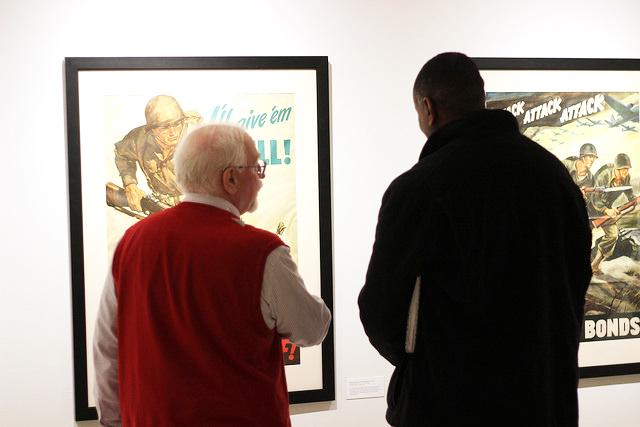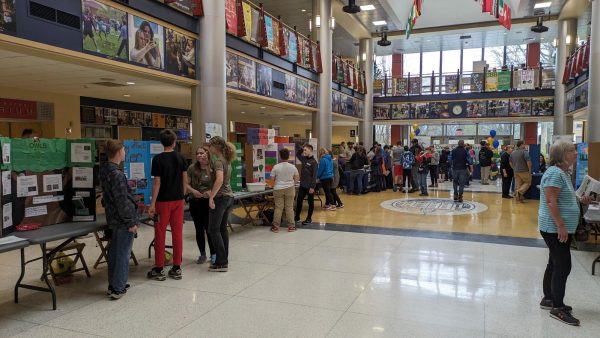‘Persuasion’ presents progaganda projects
Professor of Art History Richard Schindler and Assistant Professor of Art Steve Prince discuss one of the pieces on display in the Doane Hall of Art in the Bowman-Penelec-Megahan Galleries on Tuesday, Jan. 24, 2017. The exhibition includes propoganda posters from World War I and II and Puerto Rico, as well as photographs from World War II.
An opening reception for the “Persuasion” exhibit in the Doane Hall of Art in the Bowman-Penelec-Megahan Galleries was held on Tuesday, Jan. 24. The exhibit, which will run until Feb. 21, presents posters from World War I, World War II and from Puerto Rico as well as photographs from the Farm Security Administration and the Office of War Information from before and during World War II.
According to Darren Miller, art department chair and director and curator of the Bowman-Penelec-Megahan Galleries at Allegheny College, the exhibit is about three specific projects where governments work to shape public opinion through the use of visual media and other kinds of propaganda.
“I think that Americans certainly have an aversion to the word propaganda because it feels sinister, but what we’re really talking about is a form of advertising,” Miller said.
Miller said it is important to reflect on the ways governments and other institutions work to shape public opinion about policies that may be important. This can include efforts to shape public opinion about governance, economy, involvement in wars and climate change.
I think it’s especially important now that we examine the ways that we’re influenced through images and through text.
— Jonathan Yee
The section of posters in the gallery from Puerto Rico are from the private collection of Ken Pinnow, professor of history, and were made by mostly Puerto Rican artists. These posters were used to publicize screenings of films from the Division of Community Education in Puerto Rico.
The other posters and photographs from World War I and World War II are part of the college’s art collection. This collection numbers over 1,000 objects and includes a mixture of student work and other objects of historical and cultural importance.
The posters work to persuade people to feel something or engage in some kind of important issue, according to Richard Schindler, professor of art history.
“The war posters encourage civilians to support the war through their money [and/or] through their activities,” Schindler said. “On the other hand, the posters collected by Professor Pinnow are more about social issues or political issues that need to be addressed—public health, disaster relief, things like that.”
According to Miller, the images in these war posters and photographs are not as powerful or persuasive as some of the other media that was popular at the time. Other important and more influential forms of media included radio, films, songs and political cartoons. Miller said although the posters and images were not the most popular, they are the most enduring and have been recontextualized as art.
Jonathan Yee, ’17, worked with Miller during the summer of 2014 as a research assistant and helped with the preparation and planning for “Persuasion.” He also co-wrote an essay on the war posters with Schindler and Greg Singer, ’15.
“I think it’s especially important now that we examine the ways that we’re influenced through images and through text,” Yee said. “The things that were exhibited in the show, they’re not totalitarian orders or commands that people have to follow, they were gentle nudges to the public to think or do certain things for them.”
According to Yee, the government spent hundreds of thousands of dollars funding the production of posters around the time of the two world wars and directing the messages and images so that there was very little artistic freedom.
“The message had to be clear and distinct so that there were no subtleties because it was a time of war,” Yee said. “But now people can just slap text onto an image on their computer and post it on the internet and it spreads way more easily and way faster.”
The exhibit has a fourth and final piece that, according to Miller, is meant as a postscript that offers a humorous view of how much one can really know about what is being communicated just by relying upon visuals. The piece is a political cartoon called “Reading Tea Leaves and Campaign Logos,” by Ward Sutton. It offers a visual analysis of the campaign logos that were used in the 2008 presidential election.
“To what extent [can visuals] really tell us something and to what extent does that really, instead, tell us something about what we think already and what we want to see?” Miller said. “What we’re hearing so much about in the news, not just from our president, but from people who are perhaps critical of our new president, is that we live in an era of post-truth, that we can present alternative facts, that we’re not even sure what the facts are or how to reach them.”
Miller said that digital media has transformed the way people think about everything.
“The problem isn’t that we have a shortage of information,” Miller said. “We have all of the world’s information at our fingertips on the internet … so I think the real challenge for us is, when we have so much information available to us, how do we determine what’s true and what’s real.”







